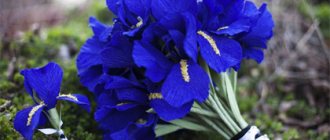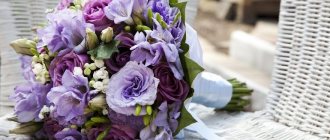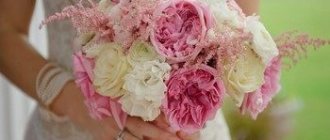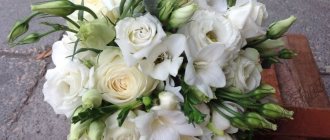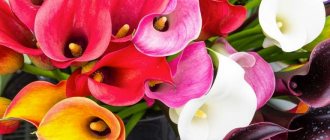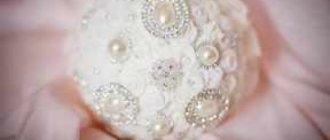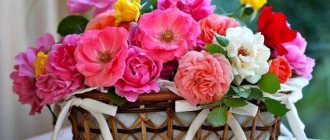Every girl dreams of a perfect wedding and tremblingly chooses a wedding bouquet for the celebration. This is an important attribute that reflects not only taste, but also the internal state of a girl, her thoughts and feelings. A bride's wedding bouquet made of white eustoma looks elegant and sweet. Delicate half-opened buds add some touchingness and special charm to the whole image. It’s not for nothing that in some countries this plant is called the “rose of love.”
Photo of a wedding bouquet of eustoma
What kind of flower is eustoma or lisianthus?
Despite all the splendor, many people can’t even imagine what this amazing flower looks like. It looks a little like a rose, so people believe that eustoma is a type of royal flower. Actually this is not true. A large bud measuring about 6-7 centimeters used to be only blue.
Subsequently, breeders developed many shades, but all of them were soft, pastel colors, since this is what suits the flower itself most.
In the floristic world, the ideal combination is eustoma and rose. Thanks to its similarity, a harmonious bouquet is obtained. Eustomas give tenderness, but royal roses give grandeur.
Beginning of work
Eustoma from beads should be assembled in parts. Let's start by making all the preparations. The easiest thing in making a flower is creating the core. We take a wire 20-30 cm long and string 6 beads on it. We fix them in the middle so that we get a small ring. Now you need to collect 4 more beads on one end of the wire. We pass the working end through 4 beads. You should end up with a circle with a filled middle. You can see how to do this in the picture above. In this way you need to create from 7 to 10 stamens. Now you need to twist all the wires into a single whole so that you get a finished core.
Features of the combination of eustoma and roses
Wedding bouquets of spray roses and eustoma.
Wedding bouquets with eustoma and roses – classic or not? This combination can rightfully be considered a classic. The traditional connection by similarity is an interesting design solution. It is ideal if you want to choose a classic option and add a modern touch to it. As a rule, brides do not want to throw such an accessory to their friends at the end of the event.
The peculiarity of an ideal and harmonious bouquet of these two flowers will lie in the color itself. It is important to choose the shades correctly and harmoniously. Roses perform a brighter and richer function, so their color should be pink, violet, blue, purple. In general, consider only rich tones.
But eustoma, on the contrary, in this case should be gentle and laconic. Pastel colors will look great.
This is interesting: Classic wedding bouquet of the bride - the inviolability of traditions
The ideal combination is:
- white eustomas and red roses;
- cream eustomas and purple roses;
- lilac eustomas and white roses.
Additional decor
As additional decor when making bouquets of eustomes, lace, satin ribbons, beads, rhinestones, decorative details and elements, brooches and cameos are used.
Eustoma is often used to create boutonnieres and bracelets.
The following types of eustome bouquets are popular:
- Bouquet cascading. The composition seems to go down. With this form of bouquet, eustoma becomes an important decorative component. Its stems are long enough that it is easy to weave them into a composition and make a kind of cascade. The decor in such bouquets is greenery or ribbons.
- A bouquet created using Biedermeier will be round in shape and will become a classic option for a bouquet of eustomes.
- A spherical bouquet of eustomes can be worn on the hand, like a handbag, or as a bouquet. Such bouquets are decorated with satin ribbons, pearl beads and glass inserts.
Packaging a bouquet of eustomes for the bride should be minimal. The flowers themselves are airy, lush and beautiful, and therefore do not require special packaging.
How to choose a bouquet
To choose the right wedding accessory, you need to study the features of two flowers in advance.
Follow our rules and you can buy a quality product:
- Don't take heavy bouquets. Choose options that you can easily carry all day. A wedding accessory should be small in size and, accordingly, weight. It would be completely unacceptable to look around at an armful of flowers.
- Ask your florist to choose flowers that do not have strong scents. Eustoma, unlike roses, has a muted scent. The royal flower, depending on the variety, can have a pronounced aroma. Try to avoid such options.
- For a more harmonious event, you can use flowers not only in a bouquet, but also as a designer decoration for the room and as an accessory for the bride’s head. Eustoma will look great on tables or woven into a girl’s wreath. As a result, you will be able to create a harmonious wedding.
- Don't be afraid to add additional flowers to your bouquet. But it is better that there are no more than 3-4 of them. Be sure to stick to the color palette.
Planting in open ground
Cultivation of the plant in open ground is carried out every year, since eustoma grows outdoors only as an annual. In temperate climates, a flower can only be grown through seedlings, so they are grown in advance in the manner described above. You can also grow a flower by seed if you follow strict cultivation rules, but this process is quite complicated.
When to plant
The optimal time for sowing crops in open ground is considered to be mid-winter. In this case, the flowers bloom in mid-summer. In temperate climates, sowing is carried out immediately after the end of the cold weather and the soil has warmed to the required temperature. Seedlings are placed in open ground only in June or July, where they will begin to bloom almost immediately.
Where to plant eustoma
In order for the flower to grow normally, the choice of site is approached with great care. Flowers are placed in open areas, with no drafts and sufficient shading at midday. Gardeners do not recommend planting crops next to objects that reflect light.
As a site, choose a flower bed with a loose nutrient substrate and a high-quality drainage layer in the soil. The plant does not tolerate strong soil and air humidity, so planting is carried out in places far from groundwater and wetlands. Select areas with neutral soil acidity.
How to plant a flower
To plant eustoma indoors, it is enough to follow certain rules:
- the area is properly processed - they dig up and remove weeds;
- a planting hole for seedlings is dug in advance, it is watered abundantly, and a high-quality drainage layer of gravel, pebbles or expanded clay is created at the bottom;
- fertilizer for flower plants or nitroammophoska is poured into the planting hole;
- a layer of sand of about 5 cm is poured over the drainage;
- the seedlings are carefully placed in the soil in the center of the hole and sprinkled with nutrient substrate on all sides;
- After planting, the seedlings are watered.
You may be interested in: Lingonberry - features of growing northern berries and medicinal properties
When planting several eustoma bushes at the same time, gaps of about 20 cm are left between the crops. The soil around the plant is carefully compacted and then covered with a thin layer of peat - a mulched layer helps prevent complete drying of the soil and ensures poor weed growth.
Options for combining eustoma and roses with other flowers
You can choose a mono bouquet, which will look great with the right color design. In this case we are talking about contrasting colors. You shouldn’t make the entire wedding accessory the same color, as everything will simply merge together.
As a result, it will not be clear how many types of plants you used. For a more original wedding accessory, you can mix several varieties of plants.
Freesia
Will help complement the airy image. The result is not an ordinary bouquet, but a real dream. Delicate tones, light texture, lush buds - only this combination can give birth to such splendor. In addition, freesia is ideal as a wreath on the head or a boutonniere for the groom.
This is interesting: The bride’s wedding bouquet is a summer version of color combinations
Alstroemeria
Exotic eustoma and royal rose require only equally rare and creative plants to be combined. Alstroemeria can easily be considered one of these. It has soft lines and clear shapes. In combination it looks simply great. especially successful if it is diluted with a satin ribbon or beads that shimmer in the sun.
Lisianthus
Lisianthus adds variety to any bridal bouquet. A tropical plant in blue and white colors can complement a bride's wedding bouquet. This is an ideal composition that is suitable for a magnificent dress and gala evenings, as well as for a relaxed family dinner and a floor-length evening dress.
Any themed weddings are suitable for a floral arrangement of lisianthus.
Selection rules
Charming plants are quite capricious. They are difficult to give the required shape, so if you do not have much experience in composing such compositions, it is better to contact a professional florist. This is especially true for complex non-standard bouquet shapes and the use of an abundance of shades.
Here are some more useful tips:
- Shrub roses have a rather spicy scent, so be sure to check in advance to see if you are allergic to it. If necessary, ask to treat the buds with a special solution that will muffle the aroma;
- Young girls look great with buds just beginning to bloom, older women - with fully formed inflorescences;
- Take care of the convenience of the bouquet handle. It should not be too wide, short, slippery, scratchy, or with protruding thorns. Remember that you will have to carry the accessory in your hands all day, so it will be useful to think about your own comfort;
Important! Roses are available all year round, but still contact the salon in advance, at least a couple of weeks before the wedding, because the desired shade or variety may not be available
- Flowers should be as fresh as possible and treated with a special composition that slows down fading. The wedding day is quite long, and the buds cannot do without help;
- Choose a bouquet when you have already completely decided on the dress, makeup, hairstyle and theme of the celebration, because even the most beautiful accessory loses its charm in an inappropriate setting.
Examples of wedding bouquets
Eustoma is often called a universal flower by florists. You can create a large number of combinations with it. And what’s most interesting is that they all give rise to combinations that are completely different from each other. In addition, the exotic flower is beautiful on its own and therefore does not require any additional plants. The eustoma bridal bouquet definitely deserves attention.
Bride's bouquet of eustoma, photo.
Florists most like the following options for wedding bouquets.
- Snow-white eustomas and scarlet bush roses - the queen of flowers add elegance, but a tropical plant will add charm and mystery.
- Blue lisianthus and snow roses are an unusual composition that is suitable for a wedding or celebration in nature. On the one hand, you get a mysterious image, and on the other, an airy one.
- Lilac eustomas and white freesias - with the help of small green buds you can add naturalness and lightness to the entire floral arrangement. The combination is suitable for magnificent celebrations. It will look especially good on brides in ball gowns.
- Pink alstroemerias and cream eustomas are a bouquet suitable for a spring celebration . It will look especially good at the beginning of spring, when everyone misses the warmth and sun so much.
This is interesting: Ivory bouquet for a wedding - choose together
Description of the species
You know that the flowers that inspired this article have many other names. It is noteworthy that some countries call plants as if they were their traditional ones - Texas bellflower, Irish, Japanese or French rose. This indicates the high demand for flowers and respect for them from people. There are also beautiful legends about them. Eustoma is often called lisianthus, which translated from Latin means “bitter flower.”
The last name was given for a reason, because the species belongs to the Gentian family. It is generally accepted that flowers do not suffer from insect pests so often, because bitter juice is unpleasant to them. In reality, this is not entirely true, and parasites can bother beautiful plants. It is generally accepted that in Europe they learned about eustoma from a botanist and at the same time a doctor from Ireland - Patrick Brown. It is difficult to say when flowers appeared in the vastness of our country.
Eustoma amazes not only because it is very similar to the queen of the garden, but also because of its shades, which are often much more luxurious and varied than those of a rose. There are any color combinations, as well as monotony - purple, lavender, blue, white, orange. Flowers are highly decorative and can be tall or short and even dwarf. The former are best grown in the garden for cutting, the latter are planted on the window of the house.
The big advantage of flowers is that after cutting they last for a very long time; here roses cannot compete. Of course, the bouquet will delight you longer if you follow some useful tips, but even without them, the bouquets will remain fresh for more than one week. Eustoma flowers have large rounded petals, the shape of the inflorescences is in the form of a bowl. They open up well, look beautiful and tender. At the same time, the stems are very dense; they begin to branch approximately from the middle. One such stem can decorate up to 35 large inflorescences, which will bloom one by one.
The flowers can be simple or double, the leaves on the stem are oval-shaped, and have a light bluish coating on them. Tall varieties can reach a height of up to one and a half meters or more, and the most dwarf ones - up to 16 cm. The first ones look luxurious along the fence, the second ones are grown at home, you can use them as a holiday gift for a girlfriend or colleague. Eustoma began to be grown in our country in the past - the 20th century, in the 90s. Since then, flowers have only gained popularity.
